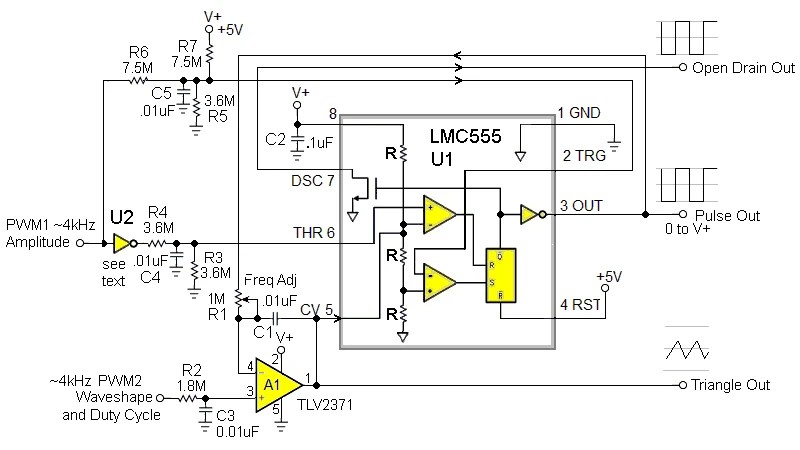There are plenty of designs out there for sawtooth and triangle function generators, many of them using the humble 555 IC. Few are readily voltage controlled, making them difficult to work with using a DAC, though. Enter this useful design posted to EDN!
The nifty design allows both waveshape and amplitude to be controlled via voltage. You could hook up a couple of potentiometers and call it done. Or, even better, you can control these parameters via PWM output from a microcontroller. Handy, no? It’s achieved by a fancy routing that sends feedback from the 555’s output pin to the CV input, instead of the usual design that uses the THR and TRG pins instead. The design also allows the production of both symmetrical and asymmetrical triangle waveforms, and as a bonus, the whole oscillator draws less than 4 mW of power.
If you’re looking for a nifty triangle/sawtooth generator that sits neatly in your otherwise-digital design, this could be for you. Or, you might like to explore the sheer mountain of other 555 hacks we’ve featured over the years. We even held a contest! If you’ve got new 555 hacks the world needs to see, don’t hesitate to drop them into the tipsline.
















Could have been done with a FPGA
Or Attiny/-Mega / ESP / etc…
Actually, no. Because of RAM latency, instruction pipeline, cache, OS, multiple threads etc. timing of program running on CPU cannot be guaranteed in any sort of way. You have to use dedicated timing chip if you want precision and accuracy.
Actually, yes.
Check out PICDiv if you want an example of how microcontrollers can be ideal in timing applications
If we’re talking about smallish microcontrollers, there’s no RAM latency, pipeline or cache problems to worry about. The other issues, like OS/threads/timing can all be controlled by skillful programmer. Even on bigger microcontrollers like Cortex M7, that have cache memories, there are ways to guarantee strict timing.
If you use a microcontroller with DMA (like a STM32F3/4), you get cycle-accurate timimg without even involving the CPU.
While this design allows for amplitude and waveshape control, I don’t see an easy way to control the frequency.
The duty cycle or wave shape control has a side effect of changing the frequency.
Using an FPGA would not have been an analog device, CV is utilized often in musical instruments. Also the math of feeding back signals is not 1 for 1 from electric to digital implementations, especially in IIR filters.
Nah, discrete components. Bonus points for using through hole.
Through hole? Are you talking about those “printed” circuit boards? Pine boards with Fahnestock clips, FTW.
Lewin have you ever used the 7555 ic chip? It’s the CMOS version of the 555 ic. Uses less current and has a larger voltage range.
> Or, even better, you can control these parameters via PWM output from a microcontroller.
Why not generate the waveforms directly by microcontroller?
If the mcu doesn’t have a DAC and you want a triangle wave, or the mcu is too busy to generate frames fast enough for the DAC. Also i think you could control an oscillator via pwm that’s oscillating faster than your mcu is capable of outputting? Idk what the range of the 555 is – does it go into mhz?
You can output a square wave and then use some opamp circuit to make a triangle. 555 has a max frequency of a few MHz, so depending on the microcontroller that’s either faster or slower than an I/O pin, but the 555 would have the advantage of having finer frequency control around the setpoint, but disadvantage of limited R/C tolerance.
Integrating over a square wave makes the amplitude vary by frequency. Putting the integrator in the feedback path of the 555 keeps the amplitude constant.
Not mentioned is that this design is by the remarkable and prolific Stephen Woodward who has had over 60 designs published through the years. And none of them trivial, many of which provide startling insight into clever analog design. My hat is off to him, and I always enjoy seeing his innovations. Highly recommended for all EEs, professional or otherwise!
But is it actually useful, or just a gimmick circuit for show? Where would you apply it?
There’s certain problems such as not being able to change the frequency, and then having the frequency change as you adjust the wave shape, which you then have to correct with a potentiometer, so what’s the point of having it voltage controlled in the first place?
It’s more useful to have a VCO with a constant amplitude and adjustable wave shape, because you can always pair it with a VCA later. I did such a thing once, but I had to scrap the plan since it had exactly the same problem: couldn’t get the frequency to stay constant while adjusting the triangle slopes. These circuits quickly blow up in complexity to the point that there’s no sense in building them.
One use: Connect it to a speaker, make it produce awful sounds, get published on HaD as having made a synthesizer
Of the 17 comments on this, this one is the only positive one. Everyone else is trying to show off and not givie credit where credit is due. This is a simple and elegant solution to a problem that meets the requirements it is design for. A beer or whatever for the person concerned.
If you read the article, the actual requirements are never stated, so we have no idea whether the idea is a simple and elegant solution for them. EDN is a community for professional engineers, so we should be allowed to judge the contributions to this standard.